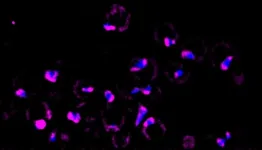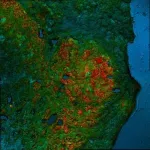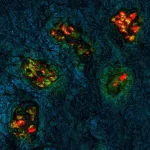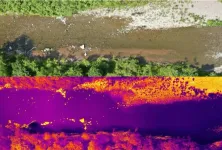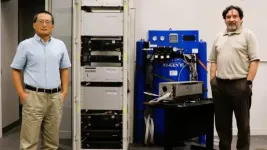(Press-News.org) Imagine the life of a yeast cell, floating around the kitchen in a spore that eventually lands on a bowl of grapes. Life is good: food for days, at least until someone notices the rotting fruit and throws them out. But then the sun shines through a window, the section of the counter where the bowl is sitting heats up, and suddenly life gets uncomfortable for the humble yeast. When temperatures get too high, the cells shut down their normal processes to ride out the stressful conditions and live to feast on grapes on another, cooler day.
This “heat shock response” of cells is a classic model of biological adaptation, part of the fundamental processes of life—conserved in creatures from single-celled yeast to humans—that allow our cells to adjust to changing conditions in their environment. For years, scientists have focused on how different genes respond to heat stress to understand this survival technique. Now, thanks to the innovative use of advanced imaging techniques, researchers at the University of Chicago are getting an unprecedented look at the inner machinery of cells to see how they respond to heat stress.
“Adaptation is a hidden superpower of the cells,” said Asif Ali, PhD, a postdoctoral researcher at UChicago who specializes in capturing images of cellular processes. "They don’t have to use this superpower all the time, but once they’re stuck in a harsh condition, suddenly, there's no way out. So, they employ this as a survival strategy.”
Ali works in the lab of David Pincus, PhD, Assistant Professor of Molecular Genetics and Cell Biology at UChicago, where their team studies study how cells adapt to stressful and complex environments, including the heat shock response. In the new study, published October 16, 2023, in Nature Cell Biology, they combined several new imaging techniques to show that in response to heat shock, cells employ a protective mechanism for their orphan ribosomal proteins – critical proteins for growth that are highly vulnerable to aggregation when normal cell processing shuts down – by preserving them within liquid-like condensates.
Once the heat shock subsides, these condensates get dispersed with the help of molecular chaperone proteins, facilitating integration of the orphaned proteins into functional mature ribosomes that can start churning out proteins again. This rapid restart of ribosome production allows the cell to pick back up where it left off without wasting energy. The study also shows that cells unable to maintain the liquid state of these condensates don’t recover as quickly, falling behind by ten generations while they try to reproduce the lost proteins.
“Asif developed an entirely new cell biological technique that lets us visualize orphaned ribosomal proteins in cells in real time, for the first time,” Pincus said. “Like many innovations, it took a technological breakthrough to enable us to see a whole new biology that was invisible to us before but has always been going on in cells that we've been studying for years.”
Loosely affiliated biomolecular goo
Ribosomes are crucial machines inside the cytoplasm of all cells that read the genetic instructions on messenger RNA and build chains of amino acids that fold into proteins. Producing ribosomes to perform this process is energy intensive, so under conditions of stress like heat shock, it’s one of the first things a cell shuts down to conserve energy. At any given time though, 50% of newly synthesized proteins inside a cell are ribosomal proteins that haven’t been completely translated yet. Up to a million ribosomal proteins are produced per minute in a cell, so if ribosome production shuts down, these millions of proteins could be left floating around unattended, prone to clumping together or folding improperly, which can cause problems down the line.
Instead of focusing on how genes behave during heat shock, Ali and Pincus wanted to look inside the machinery of cells to see what happens to these “orphaned” ribosomal proteins. For this, Ali turned to a new microscopy tool called lattice light sheet 4D imaging that uses multiple sheets of laser light to create fully dimensional images of components inside living cells.
Since he wanted to focus on what was happening to just the orphaned proteins during heat shock, Ali also used a classic technique called “pulse labeling” with a modern twist: a special dye called a “HaloTag” to flag the newly synthesized orphan proteins. Often when scientists want to track the activity of a protein inside a cell, they use a green fluorescent protein (GFP) tag that glows bright green under a microscope. But since there are so many mature ribosomal proteins in a cell, using GFPs would just light up the whole cell. Instead, the pulse labelling with HaloTag dye allows researchers to light up just the newly created ribosomes and leave the mature ones dark.
Using these combined imaging tools, the researchers saw that the orphaned proteins were collected into liquid-like droplets of material near the nucleolus (Pincus used the scientific term “loosely affiliated biomolecular goo”). These blobs were accompanied by molecular chaperones, proteins that usually assist the ribosomal production process by helping fold new proteins. In this case, the chaperones seemed to be “stirring” the collected proteins, keeping them in a liquid state and preventing them from clumping together.
This finding is intriguing, Pincus said, because many human diseases like cancer and neurodegenerative disorders are linked to misfolded or aggregated clumps of proteins. Once proteins get tangled together, they stay that way too, so this “stirring” mechanism seems to be another adaptation.
“I think a very plausible general definition for cellular health and disease is if things are liquid and moving around, you are in a healthy state, once things start to clog up and form these aggregates, that's pathology,” Pincus said. “We really think we're uncovering the fundamental mechanisms that might be clinically relevant, or at least, at the mechanistic heart of so many human diseases.”
Finding structure at an atomic scale
In the future, Ali hopes to employ another imaging technique called cryo-electron tomography, an application using an electron microscope while cell samples are frozen to capture images of their interior components at an atomic level of resolution. Another advantage of this technique is that it allows researchers to capture 3D images inside the cell itself, as opposed to separating and preparing proteins for imaging.
Using this new tool, the researchers want to peer inside the protein condensates to see if they are organized in a way that helps them easily disperse and resume activity once the heat shock subsides.
“I have to believe they’re not just jumbled up and mixed together,” Pincus said. “What we’re hoping to see within what looks like a disorganized jumbled soup, there’s going to be some structure and order that helps them start regrowing so quickly.”
Research reported in this press release was supported by the National Institutes of Health (NIH) under award numbers R01 GM138689 and R35 GM144278, along with support from the Neubauer Family Foundation, and the National Science Foundation (NSF) Quantum Leap Challenge Institute Quantum sensing for Biophysics and Bioengineering grant OMA-2121044. Additional authors include Rania Garde, Olivia C. Schaffer, Jared A. M. Bard, Kabir Husain, Samantha Keyport Kik, Kathleen A. Davis, Sofia Luengo-Woods, Maya G. Igarashi, D. Allan Drummond, and Allison H. Squires from the University of Chicago. The content is solely the responsibility of the authors and does not necessarily represent the official views of the NIH or NSF.
END
Peering inside cells to see how they respond to stress
Researchers at the University of Chicago combine state-of-the-art imaging techniques to see how cells conserve energy and pick up where they left off after heat shock.
2023-10-16
ELSE PRESS RELEASES FROM THIS DATE:
Effectiveness of monovalent mRNA vaccines against Omicron XBB infection in Singaporean children
2023-10-16
About The Study: The results of this study including 121,000 Singaporean children ages 1 through 4 suggest that completion of a primary mRNA vaccine series provided protection against SARS-CoV-2 infection. Although incidence of hospitalization and severe illness is low in this age group, there is potential benefit of vaccination in preventing infection and potential sequelae.
Authors: Liang En Wee, M.R.C.P., M.P.H., of the National Centre for Infectious Diseases in Singapore, is the corresponding author.
To access the ...
Changes in care use and financial status associated with dementia in older adults
2023-10-16
About The Study: The findings of this study demonstrated that the incremental changes associated with dementia in regard to older adults’ long-term care and financial burden are substantial. Family care availability should be accounted for in a comprehensive assessment of predicting the effects of dementia.
Authors: Hwa Jung Choi, Ph.D., of the University of Michigan in Ann Arbor, is the corresponding author.
To access the embargoed study: Visit our For The Media website at this link https://media.jamanetwork.com/
(doi:10.1001/jamainternmed.2023.5482)
Editor’s Note: Please see the article for additional information, including other authors, author contributions ...
Researchers develop innovative technique for distinguishing tumor from normal tissue
2023-10-16
Mass General Brigham investigators tested their approach using specimens from multiple cancer types, including liver, brain, tongue, skin, breast, bone and soft tissue
Their visual and quantitative technique, which combines an injected FDA-approved drug with high-speed cameras to detect changes occurring in a billionth of a second, had an accuracy of 97% across tumor types
Removing a patient’s tumor while sparing healthy tissue requires exquisite precision, but often surgeons must rely on their eyes and hands to determine where to cut. A team led ...
Climate change coping mechanism discovered in humble algae
2023-10-16
One of the building blocks of ocean life can adapt to cope with the effects of climate change, according to new research from the University of East Anglia (UEA).
The discovery holds promises for biotechnology developments that could counter the negative effects of changing environmental conditions, such as ocean warming and even the reduction in the productivity of crops.
Looking at eukaryotic phytoplankton, also referred to as microalgae, found over large parts of the ocean, the international team led by UEA’s Prof Thomas Mock discovered the algae have found a way to cope with nutrient starvation, which is predicted to ...
Wildfires threaten environmental gains in climate-crucial Amazon
2023-10-16
Despite steps toward decreasing deforestation, uncontrolled wildfires are threatening environmental gains in Brazilian Amazonia, one of the world’s most critical carbon sinks and a region of high biological and cultural diversity.
An international team of scientists are raising the alarm in a letter published today in Nature Ecology & Evolution. ‘Increasing wildfires threaten progress on halting deforestation in Brazilian Amazonia’ is co-authored by researchers at the University of East Anglia (UEA) and the University of South Alabama, which led the study. Other contributors ...
Dementia’s financial & family impact: New study shows outsize toll
2023-10-16
Most people think of dementia as something that affects a person’s brain. But a new study shows just how much damage it does to a person’s wallet and bank account too – as well as the higher demands it places on their family members.
In all, people diagnosed with dementia saw their out-of-pocket spending for health care more than double, and their net worth decline by more than 60%, within the first eight years of being diagnosed, the study finds.
Meanwhile, other people of similar ages and in similar health, ...
Early behavioral health problems need earlier interventions
2023-10-16
CINCINNATI--A six-year study that analyzed data from a 25-question screening tool found alarming evidence of unhealthy behavioral trajectories starting as early as age 2 among families affected by low income and other social stressors.
Findings from the study led by Robert Ammerman, PhD, and colleagues at Cincinnati Children’s were published Oct. 16, 2023, in JAMA Pediatrics. (DOI: 10.1001/jamapediatrics.2023.4229)
Experts may not be surprised by another study reporting an association between family stress and child behavioral problems. However, the early ages of onset and severity of behavioral problems were unexpected. Importantly, ...
Salmon cooling stations
2023-10-16
16 October 2023
The Geological Society of America
Release No. 23-36
Contact: Justin Samuel
+1-303-357-1026
jsamuel@geosociety.org
For Immediate Release
Pittsburgh, Pa., USA: You’ve heard of the salmon run: upon reaching sexual maturity, wild Atlantic salmon, which are born in freshwater rivers but spend most of their adult life in the ocean, swim upstream all the way back to their birthplace to spawn. This remarkable migration—a journey thousands of miles long, against the current—is filled with obstacles, from dams to hop over to hungry bears to dodge.
Climate warming has brought about an additional hurdle for wild Atlantic salmon populations: rising water ...
Measuring the changing soundscape in Glacier National Park
2023-10-16
16 October 2023
The Geological Society of America
Release No. 23-38
Contact: Justin Samuel
+1-303-357-1026
jsamuel@geosociety.org
For Immediate Release
Pittsburgh, Pa., USA: From the eerie echo of a bugling elk to the gentle swoosh of water lapping against a stony shore, a unique combination of sounds helps distinguish each national park. This acoustic environment, as perceived by humans, is known as a soundscape, and it is a vital attribute—albeit one that is increasingly under threat from anthropogenic noise.
Whether from the hum ...
A clean-energy future for legacy coal?
2023-10-16
Lehigh University researchers Carlos Romero, Director of the Energy Research Center (ERC), co-Associate Director of the Institute for Cyber Physical Infrastructure and Energy (I-CPIE), and a faculty member in the Department of Mechanical Engineering and Mechanics, and Zheng Yao, Principal Research Scientist at the ERC, have been awarded a DOE STTR (Department of Energy Small Business Technology Transfer) award for Phase II of their proposal, “Machine Learning Enhanced LIBS to Measure and Process Biofuels ...
LAST 30 PRESS RELEASES:
When is it time to jump? The boiling frog problem of AI use in physics education
Twitter data reveals partisan divide in understanding why pollen season's getting worse
AI is quick but risky for updating old software
Revolutionizing biosecurity: new multi-omics framework to transform invasive species management
From ancient herb to modern medicine: new review unveils the multi-targeted healing potential of Borago officinalis
Building a global scientific community: Biological Diversity Journal announces dual recruitment of Editorial Board and Youth Editorial Board members
Microbes that break down antibiotics help protect ecosystems under drug pollution
Smart biochar that remembers pollutants offers a new way to clean water and recycle biomass
Rice genes matter more than domestication in shaping plant microbiomes
Ticking time bomb: Some farmers report as many as 70 tick encounters over a 6-month period
Turning garden and crop waste into plastics
Scientists discover ‘platypus galaxies’ in the early universe
Seeing thyroid cancer in a new light: when AI meets label-free imaging in the operating room
Neutrophil-to-lymphocyte ratio may aid risk stratification in depressive disorder
2026 Seismological Society of America Annual Meeting
AI-powered ECG analysis offers promising path for early detection of chronic obstructive pulmonary disease, says Mount Sinai researchers
GIMM uncovers flaws in lab-grown heart cells and paves the way for improved treatments
Cracking the evolutionary code of sleep
Medications could help the aging brain cope with surgery, memory impairment
Back pain linked to worse sleep years later in men over 65, according to study
CDC urges ‘shared decision-making’ on some childhood vaccines; many unclear about what that means
New research finds that an ‘equal treatment’ approach to economic opportunity advertising can backfire
Researchers create shape-shifting, self-navigating microparticles
Science army mobilizes to map US soil microbiome
Researchers develop new tools to turn grain crops into biosensors
Do supervised consumption sites bring increased crime? Study suggests that’s a myth
New mass spec innovation could transform research
Maternal nativity, race, and ethnicity and infant mortality in the US
Migration-related trauma among asylum seekers exposed to the migrant protection protocols
Jupiter’s moon Europa has a seafloor that may be quiet and lifeless
[Press-News.org] Peering inside cells to see how they respond to stressResearchers at the University of Chicago combine state-of-the-art imaging techniques to see how cells conserve energy and pick up where they left off after heat shock.
